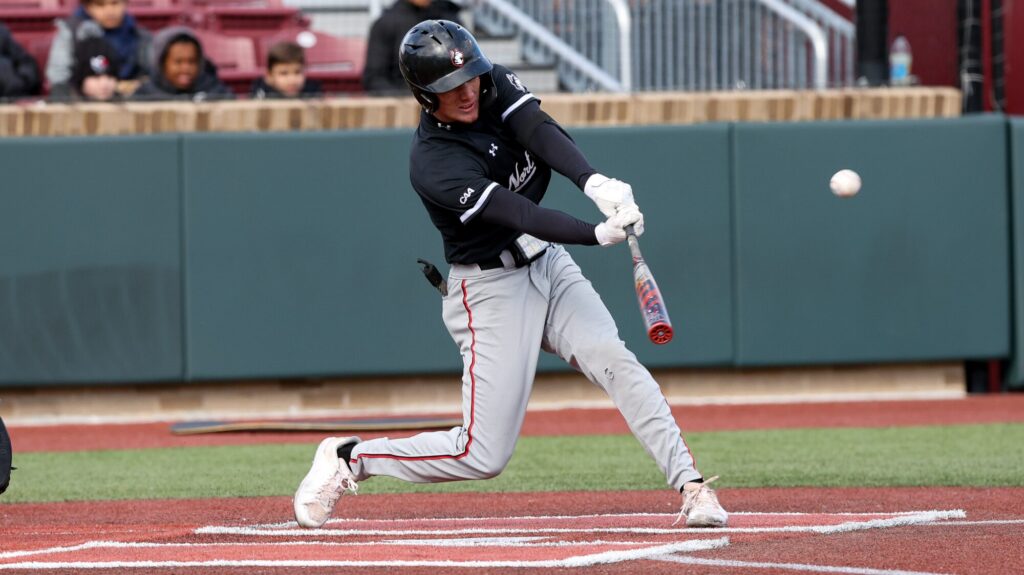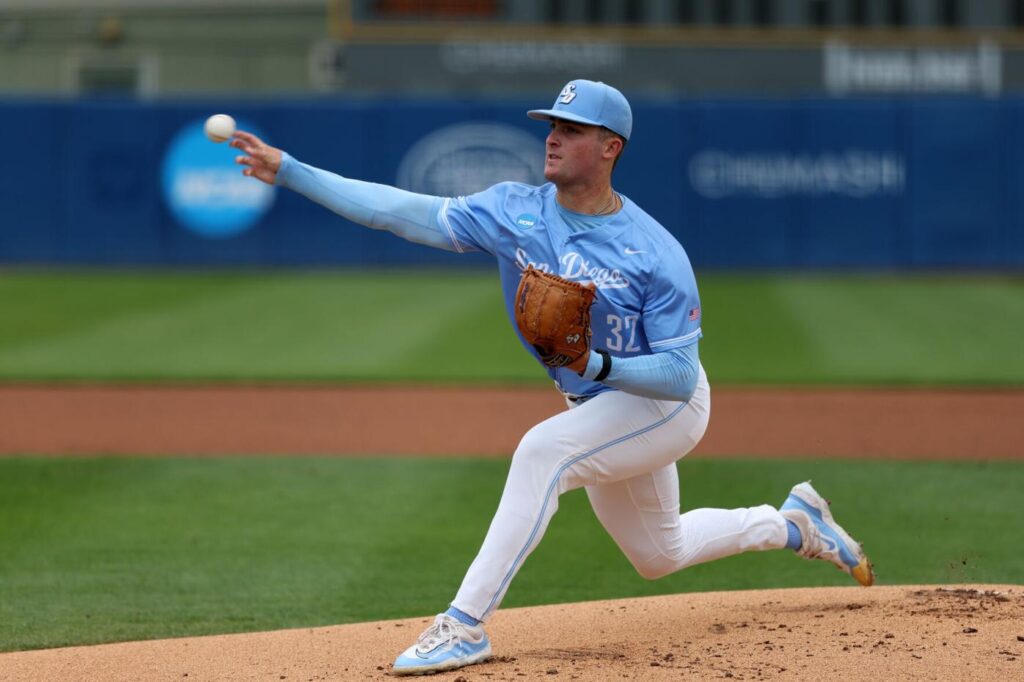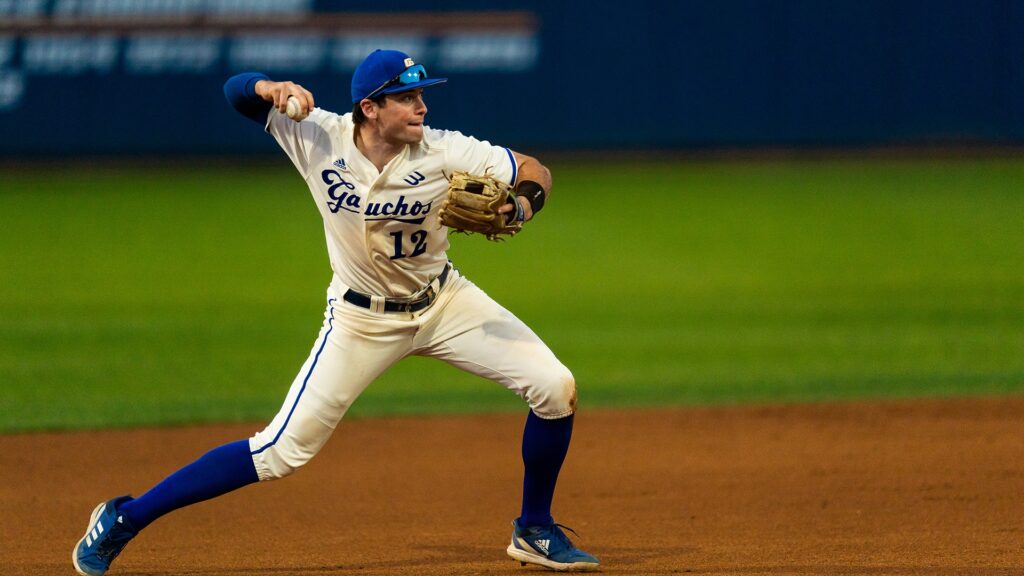College baseball wouldn’t be half as charming if not for the mid-majors. There’s beauty in watching mid-majors breaking through with upsets or simply proving they’re as good, as the Power 5 programs.
These schools tend to produce to produce pro players. Jacob Wilson, Nolan Schanuel, Mike Boeve, Ben Williamson, Cole Carrigg, Carson Roccaforte, Joe Whitman, and Cade Kuehler went on Day 1 last year.
Here are this year’s best mid-major prospects, led by a potential Top 10 pick.
1. Trey Yesavage, RHP — East Carolina

| G | IP | ERA | SO | BB |
|---|---|---|---|---|
| 15 | 93.1 | 2.03 | 145 | 32 |
Yesavage works downhill from an over-the-top slot, led by a mid-90s fastball up to 98 mph with massive riding life, particularly at the top of the zone. He’s adept at locating down in the zone, setting up his offspeed stuff.
Yesvage’s changeup developed this season, perhaps the biggest reason his stock shot through the roof, giving him an additional weapon versus left-handed batters. He throws a slider and cutter which tend to blend in the mid-80s.
He has a curveball, too, a pitch he threw a lot more a year ago, but it’s a robust arsenal and a starter’s frame with No. 3 or better upside.
2. Walker Janek, C — Sam Houston State

| AVG | OBP | SLG | HR | BB | SO |
|---|---|---|---|---|---|
| .364 | .476 | .709 | 17 | 40 | 45 |
A productive catcher from Sam Houston, Janek’s greatest appeal is he’s one of the few college players who’s pretty much a lock to stick at an up-the-middle position at the top of this class.
Janek is an above-average defender with above-average framing skills, explosiveness and athleticism behind the plate, and the arm strength and accuracy to consistently manage the running game.
Janek caught over half of the would-be base stealers this spring, and 36% of them on the Cape last summer, an impossible feat to ignore with MLB’s changes to the modern game encouraging more running, plus the lack of complete catchers.
At the plate, Janek has plus raw power, specifically to the pull side, and he’s consistently hit both in the spring and during the summer on the Cape. Janek suffers from the same caveats other smaller-school hitters face, which is the lack of competition, but the track record speaks for itself.
3. Kyle DeBarge, SS — Louisiana-Lafayette

| AVG | OBP | SLG | HR | BB | SO |
|---|---|---|---|---|---|
| .356 | .418 | .699 | 21 | 24 | 30 |
What DeBarge lacks in size he makes up for with loud production at the plate. He’s a capable hitter who plus feel for the barrel and can consistently impact the baseball. Although he’ll chase a fair bit, he makes plenty of contact, even out of the zone.
DeBarge hit 21 home runs this year, suggesting it’s sensible to believe he gets average power at the big-league level. He’s a good athlete with a plus arm who has a pretty good shot at sticking at shortstop long-term.
4. Mike Sirota, CF — Northeastern

| G | IP | ERA | SO | BB |
|---|---|---|---|---|
| 14 | 77.2 | 2.67 | 121 | 28 |
Sirota had been a consistent performer throughout his career, including on the Cape, but took a step back in production in 2024. He’s a strong player with plus athleticism, sticking as an average or better glove long-term, potentially in center.
He; ‘ll see a lot of pitches, occasionally toeing the line between patient and passive, but his feel for the strike zone stands out and there’s legitimate power here despite the off-season.
6. Cole Mathis, 1B — College of Charleston

Mathis broke out on the Cape last summer, flashing a very appealing offensive profile. This spring, he bounced back from a slow start to put him in a good position for this Draft.
| Games | AVG | OBP | SLG | HR | BB | SO |
|---|---|---|---|---|---|---|
| Before March 30 (21 games) | .197 | .371 | .368 | 1 | 16 | 12 |
| After March 29 (31 games) | .427 | .541 | .831 | 12 | 30 | 20 |
That torrid stretch late likely puts him in the Day 1 conversation, despite the likelihood he’s a first baseman. It’s a plus approach with plus power and above-average contact skills. The profile is not too dissimilar to Tyler Locklear, the Mariners’ second-round pick two years ago, and he’s hit his way to the upper minors and had a cup of coffee in the majors this season.
7. Ryan Johnson, RHP — Dallas Baptist

| G | IP | ERA | SO | BB |
|---|---|---|---|---|
| 16 | 106 | 2.21 | 151 | 14 |
Ryan Johnson is unique as a 6-foot-6 righty with long levers. Calling Johnson’s delivery unorthodox would be an understatement; he sets a quick pace and there’s practically no leg kick, only a stride, and more head whack then you ever want to see.
Despite it all, Johnson has always thrown strikes. His fastball gets up to 99 mph, but he throws it just 29% of the time, second to his slider. Johnson’s third pitch is a cutter serving as an effective bridge to his best two offerings.
He projects to pitch in the majors, aided by deception, consistent strike-throwing, and plenty of weak contact.
8. Daniel Eagen, RHP — Presbyterian

| G | IP | ERA | SO | BB |
|---|---|---|---|---|
| 14 | 77.2 | 2.67 | 121 | 28 |
Eagen’s an interesting follow, a complete pop-up name from Presbyterian, hardly the most prolific baseball school. A prototypical, 6-foot-4 right-hander with projection, he throws from a high slot, working north-south with his fastball and two breaking balls.
He’ll grab 96 mph, sitting more low-90s with some ride partially nullified by the arm angle, and he can spray the pitch some. His money pitch is a plus 12-6 curveball. He will occasionally mix in a slider.
9. Ivan Brethowr, OF — UC Santa Barbara

| AVG | OBP | SLG | HR | BB | SO |
|---|---|---|---|---|---|
| .275 | .402 | .566 | 15 | 25 | 42 |
Brethowr gets some Aaron Judge comps from a physical standpoint because he’s a 6-foot-6 college right fielder with massive power from California.
He does a good job keeping his swing compact, which can be problematic for long-armed hitters. He’s got a shot at sticking in a corner outfield spot, with first base a backup plan.
The obvious selling point here is that power, and Brethowr generates natural loft in his swing, producing consistent barrels that may get him to 30-plus homers.
10. Josh Randall, RHP — San Diego

| G | IP | ERA | SO | BB |
|---|---|---|---|---|
| 14 | 72.1 | 3.73 | 84 | 27 |
An Arizona transfer, Randall came onto the scene as a starter this year after pitching a combined 17.2 innings the following two years. Attacking from a low 3/4, slinger slot, Randall works very east-west.
His fastball gets up to 98 MPH, but given how this was his first year starting with any consistency and he worked 72 innings, the velocity was up and down. The fastball flashes intriguing hopping action when it’s rarely elevated, likely due to his low release.
Randall also throws an above-average, high-spin slider and a power changeup with late sink and run. All pitches project as average or better offerings.
He fits in the bucket of pitchers with stuff that plays in the bullpen as a fallback if starting doesn’t work out, and a lot of the profile rides on his ability to throw consistent strikes.
11. Fenwick Trimble, OF — James Madison

A lanky outfielder, Trimble has plenty of hitter-ish characteristics, and unlike some of his peers, has performed well against Power 5 schools.
There’s some feel to hit and sneaky power. Adding more muscle could help him max out the power and fit in an outfield corner.
12. Zander Darby, 3B — UC Santa Barbara

| AVG | OBP | SLG | HR | BB | SO |
|---|---|---|---|---|---|
| .275 | .347 | .420 | 6 | 22 | 40 |
Despite solid tools, it’s never come together for Darby from a performance point of view. On the surface, Darby does a lot of things right in the batter’s box, refusing to chase, and making contact, all while having solid-average power.
Darby will appeal to teams who recognize what’s under the hood, and think there’s a fix to unlock his potential.
Photo of Trey Yesavage courtesy of ECU Athletics
Photo of Walker Janek courtesy of Sam Houston Athletics
Photo of Kyle DeBarge courtesy of Rain’ Cajuns
Photo of Mike Sirota courtesy of Northeastern University Athletics
Photo of Cole Mathis courtesy of College of Charleston Athletics
Photo of Ryan Johnson courtesy of Dallas Baptist University
Athletics
Photo of Daniel Eagen courtesy of Presbyterian College
Photo of Ivan Brethowr courtesy of UC Santa Barbara
Photo of Fenwick Trimble courtesy of James Madison University Athletics
Photo of Zander Darby courtesy of UC Santa Barbara
- MLB DRAFT: Bazzana, Smith lead debuts for top picks - September 4, 2024
- Prospect notes on Rockies, D-Backs, Mariners, led by Troy, Arroyo, Karros - August 2, 2024
- MLB DRAFT: Boctor’s 5 best classes - July 17, 2024















